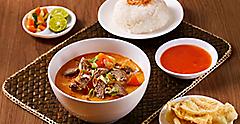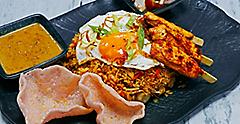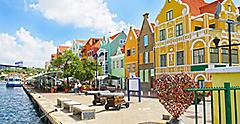The History Of Indonesian Food In Caribbean Cuisine
By Chantae Reden | Published on March 22, 2022
Indonesia Blends Its Culture and History Into Its Food
I follow the savory smell of peanut sauce and tiptoe into the kitchen of a tiny warung on the island of Lombok to peek at how the chef made my plate of simple vegetables taste so delicious. Piles of chopped ginger, chiles, garlic, and a dish of palm sugar wait to be tossed into a pan of oil. I'm on assignment to write a travel guidebook about a handful of islands in Indonesia, and with a notebook in hand, I'm ready to find out the secrets behind the best Indonesian food I've ever tasted. It takes a few seconds for the chef to notice me.
"I combine sweet, sour, spicy, and salty in one dish," the chef explains. This culinary philosophy, it turns out, is key to Indonesian cuisine and is the base of most traditional dishes from the region. Each ingredient maintains its distinct flavor while the combination provides a sense of complexity.
With over 6,000 inhabited islands throughout Indonesia, there are numerous dishes to try, each with their own unique spin depending on the area. In the early 17th century, Indonesian spices and recipes arrived on the shores of the Caribbean, where they can be savored in even more unique ways today.
How Indonesian Cuisine Traveled To The Caribbean

Paddy fields are where crops like rice are grown.
Venture to Indonesia, and you're bound to find verdant rice paddies growing the crop that has been a staple of the archipelago for at least 3,500 years. While rice itself may be humble, the ingredients its paired with hold intriguing histories. Merchants, missionaries, and colonizers crossed through Indonesia's waters, swapping spices and seeds at marketplaces and introducing new cooking methods in the kitchen. Some of Indonesia's iconic sauces feature chiles originally from Mexico and peanuts from the Americas.
In the late 1500s, Dutch traders ventured to the Indonesian islands of Maluku and returned with spices like cloves, mace, and nutmeg. These expeditions were so lucrative, the islands were deemed "The Spice Islands," and by the early 1600s, the Dutch East India Company (VOC) established a trading post on Java, Indonesia. The Dutch government granted the VOC semi-governmental powers and resources. By the end of the 1600s, the VOC controlled the region, deemed the Dutch East Indies, through force.


Dutch colonization also expanded to the Caribbean throughout the 1600s, notably on the islands of Sint Maarten, Bonaire, Sint Eustatius, Curaçao, Saba, and Aruba (today's Dutch Caribbean). Other Caribbean islands like Saint Croix, Tobago, Tortola, Saint Thomas, and Anegada also had a Dutch presence during this time through the Dutch West India Company.
Though the Caribbean and Indonesian archipelagos are over 17,000 miles apart, they've been linked through a shared history of Dutch colonization and occupation. Dutch adoption of Indonesian cuisine and the Indonesian diaspora are why you can find authentic Indonesian fare in the heart of the Caribbean, often blended with other flavor combinations and cooking techniques from other European territories.
Indo Caribbean Cooked Meals You Won't Want To Miss
Before you dig in, it's essential to get acquainted with sambal. Sambal is the condiment of choice in Indonesia, a relish typically made from an aromatic blend of chiles, shrimp paste, garlic, shallots, sugar, and lime juice. The magic of sambal is that it goes well with just about every Indonesian dish, even adding pep to plain rice. If sambal is offered, always say yes. But I recommend sampling a small taste of the relish first, as spice levels range from barely an ember to pure fire.


Dive into a cozy bowl of soto, a hearty soup made with meat, vegetables, spices, and broth. Soto recipes vary greatly, and chefs often hold their secret family spice combinations close to their heart. If comfort is what you crave, dig into a steamy bowl of soto ayam made with shredded chicken, boiled egg, fresh cabbage, scallion, a squeeze of lime, ginger, and fried onions. Soto betawi is made with beef and potatoes stewed with coconut milk, kaffir lime leaves, garlic, ginger, chiles, scallions, and a dash of sweet soy sauce. No matter what variation youv go for, this soup will warm you to your core.
Not all Indonesian cuisine in the Caribbean is meat-based, and gado gado is one of the most popular vegetarian meals. Seasonal fresh vegetables are blanched and served alongside fried tempeh, tofu, or eggs, all smothered in a sweet peanut sauce. Gado gado isn't complete without something crunchy on top, like crispy fried onions or crushed peanuts.

For a true feeling of Indonesia in the Caribbean, order a plate of nasi goreng, which means fried rice in Indonesian. Rice is wok fried with vegetables, meat, and egg and typically served as one large scoop with a fried egg on top. Swirl a spoonful of sambal or two into the rice for extra kick. Best of all, you can order this meal any time of day and still have an authentic experience — many Indonesian people start their morning with nasi goreng. Order mie goreng to savor the same dish with egg noodles in lieu of fried rice.
If every menu item sounds too good to be true, opt for the rijsttafel to sample dishes simmering with an array of flavors. The chef decides which dishes are worthy of being featured, and you'll enjoy small plates of the restaurant's best offerings served alongside a bed of steamed white rice.
Book Now
Where To Try The Best Indonesian Food In The Caribbean?

While many of the islands in the region offer exciting Indonesian fare, let your tastebuds lead the way to the islands with a strong Dutch-Indonesian influence, like Aruba, Bonaire, Curaçao, Tobago, and Sint Maarten, to name a few. On these islands, swimming in crystalline waters, visiting historical sites, exploring nature parks, and lounging on palm shaded beaches will undoubtedly help you work up an appetite for the best Indonesian food the Caribbean has to offer.
Aruba has a handful of Indonesian restaurants, making it one of the best places to eat in the Caribbean if you have a penchant for spice. Surinamese-Indonesian restaurant Indo serves classics like chicken and beef sate, gado gado, and soto. The restaurant is known for their heaping plates of bami goreng, egg fried noodles with chicken or beef, vegetables, egg and shrimp, and vegan versions are available upon request. Another worthwhile stop is Café Restaurant Yanti, a Surinamese-Indonesian fusion restaurant serving generous portions of sate sandwiches, roasted pork in tangy sweet and sour sauce, and steamed vegetables mixed with spicy shredded coconut.

On Curaçao, Lindhuis Daniel serves some of the most creative and authentic Indonesian food in the Caribbean, a must-visit while on your island foodie vacation. Their rijsttafel is best enjoyed by at least two people and comes with five select Indonesian dishes, rice, crispy spring rolls, fried bananas, crunchy spiced peanuts, and of course, sambal. The thatched roof and spacious setting of Bali Mixed Asian Restaurant is also a top contender for Indonesian cuisine. Here you can dine on plates of rice or egg noodles served with spiced beef, shrimp, chicken, or pork. For a lunch with locals, Batik Asli serves a jaw-dropping 14-plate rijsttafel, sate, nasi goreng and other classics.
While there are seemingly infinite variations of ways to cook the same dish throughout Indonesia — and each region will tell you their recipe is the right one — there are some meals you should not pass up, no matter where you find them.





